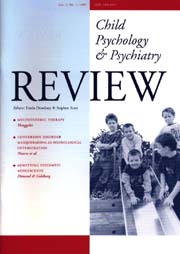Crossref Citations
This article has been cited by the following publications. This list is generated based on data provided by
Crossref.
Pritchard, Colin
and
Butler, Alan
2000.
A follow-up study of criminality, murder and the cost of crime in cohorts of 'Excluded-From-SchooP and 'Looked-After-Children' adolescents in England.
International Journal of Adolescent Medicine and Health,
Vol. 12,
Issue. 2-3,
Bowers, Tony
2001.
Cracking the Code for EBD.
Emotional and Behavioural Difficulties,
Vol. 6,
Issue. 1,
p.
19.
Williams, Richard
and
Salmon, Gill
2002.
Collaboration in commissioning and delivering child and adolescent mental health services.
Current Opinion in Psychiatry,
Vol. 15,
Issue. 4,
p.
349.
Déry, Michèle
Toupin, Jean
Pauzé, Robert
and
Verlaan, Pierrette
2004.
Frequency of Mental Health Disorders in a Sample of Elementary School Students Receiving Special Educational Services for Behavioural Difficulties.
The Canadian Journal of Psychiatry,
Vol. 49,
Issue. 11,
p.
769.
Salmon, Gill
and
Rapport, Frances
2005.
Multi-agency voices: A thematic analysis of multi-agency working practices within the setting of a Child and Adolescent Mental Health Service.
Journal of Interprofessional Care,
Vol. 19,
Issue. 5,
p.
429.
Cantor, James M.
Kuban, Michael E.
Blak, Thomas
Klassen, Philip E.
Dickey, Robert
and
Blanchard, Ray
2006.
Grade Failure and Special Education Placement in Sexual Offenders’ Educational Histories.
Archives of Sexual Behavior,
Vol. 35,
Issue. 6,
p.
743.
Déry, Michèle
Lapalme, Mélanie
Toupin, Jean
Verlaan, Pierrette
and
Pauzé, Robert
2007.
Hétérogénéité des troubles du comportement au primaire et perceptions de la situation sociale et familiale des élèves.
Revue des sciences de l'éducation,
Vol. 33,
Issue. 1,
p.
109.
COOPER, PAUL
2008.
Like Alligators Bobbing for Poodles? A Critical Discussion of Education, ADHD and the Biopsychosocial Perspective.
Journal of Philosophy of Education,
Vol. 42,
Issue. 3-4,
p.
457.
Skidmore, Michael
Dede, Yemi U.
and
Moneta, Giovanni B.
2009.
Role models, approaches to studying, and self‐efficacy in forensic and mainstream high school students: a pilot study.
Educational Psychology,
Vol. 29,
Issue. 3,
p.
315.
MacKay, Tommy
Reynolds, Sue
and
Kearney, Maura
2010.
From attachment to attainment: The impact of nurture groups on academic achievement.
Educational and Child Psychology,
Vol. 27,
Issue. 3,
p.
100.
Smythe, Ian
2011.
Dyslexia.
British Journal of Hospital Medicine,
Vol. 72,
Issue. 1,
p.
39.
Murrihy, Rachael C.
2011.
Clinical Handbook of Assessing and Treating Conduct Problems in Youth.
p.
295.
Richards, Louise Marie-Elaine
2013.
It is time for a more integrated bio-psycho-social approach to ADHD.
Clinical Child Psychology and Psychiatry,
Vol. 18,
Issue. 4,
p.
483.
Lizotte, Shelbie
Déry, Michèle
and
Verlaan, Pierrette
2013.
Caractéristiques familiales d’élèves du primaire ayant des troubles extériorisés et intériorisés.
Nouveaux cahiers de la recherche en éducation,
Vol. 11,
Issue. 2,
p.
189.
Déry, Michèle
Laventure, Myriam
Toupin, Jean
Verlaan, Pierrette
and
Pauzé, Robert
2013.
Adaptation scolaire et sociale d’élèves ayant reçu des services éducatifs complémentaires pour troubles de comportement dès le début de leur scolarité.
Nouveaux cahiers de la recherche en éducation,
Vol. 10,
Issue. 1,
p.
47.
Pauzé, Robert
Déry, Michèle
Yergeau, Éric
and
Touchette, Luc
2013.
Diversité des profils cliniques des familles des enfants présentant des problèmes de comportement en milieu scolaire.
Nouveaux cahiers de la recherche en éducation,
Vol. 8,
Issue. 2,
p.
27.
Déry, Michèle
Lapalme, Mélanie
and
Yergeau, Éric
2013.
Les services scolaires et sociaux offerts aux élèves du primaire présentant des troubles de comportement.
Nouveaux cahiers de la recherche en éducation,
Vol. 8,
Issue. 2,
p.
37.
Richards, Louise
2017.
Critical Issues in Child and Adolescent Mental Health.
p.
85.
Verlaan, Pierrette
Déry, Michèle
Temcheff, Caroline E.
and
Toupin, Jean
2018.
Longitudinal Determinants of School-Based Mental Health Service Use for Girls and Boys with Externalizing Behavior Problems.
School Mental Health,
Vol. 10,
Issue. 3,
p.
322.
MacKay, Tommy
2018.
Can the psychology of education enhance social wellbeing? A national vision for intergenerational change.
Vernon Wall Lecture,
Vol. 1,
Issue. 38,
p.
4.




